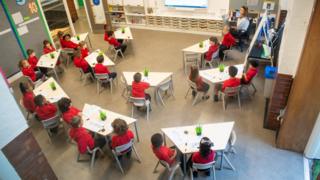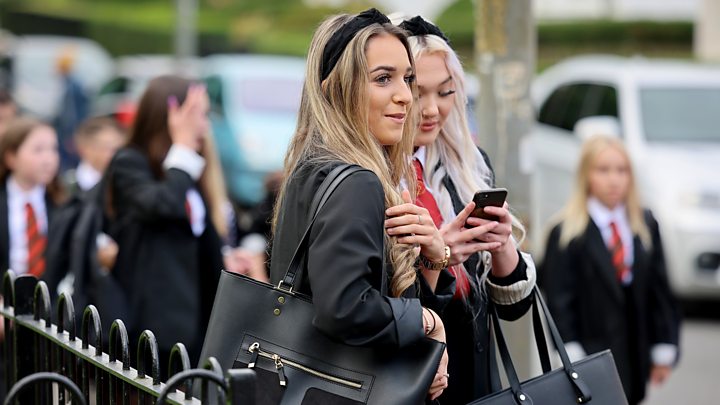 Image copyright PA Media
Image copyright PA MediaMillions of pupils in England are returning to school after the unprecedented shutdown linked to the Coronavirus pandemic.
Schools will look different, with one way systems, screens keeping pupils apart and staggered start times.
Many pupils will be given inductions so they understand the new rules, such as staying in their "bubble" groups and where to use social distancing.
Teachers will be assessing what and how much their pupils need to catch up.
It has been almost six months since schools were closed by the Education Secretary Gavin Williamson.
They soon reopened to vulnerable pupils and key worker children, but only a fraction of the national school population returned to any form of face-to-face lessons over the summer term.
The rest were required to carry on learning from home, but levels of support and interactive teaching have been very different from place to place.
It is not clear how many parents are planning to send their children back, although attendance is compulsory in England.
Some recent polls suggest families are keen to see children back in class but others have not been so positive and in Scotland, where pupils returned several weeks ago, official statistics show one in 10 pupils is absent.
Pupils in Northern Ireland have already returned, and those in Wales are returning later this week.
But England's schools minister Nick Gibb has urged parents to send their children back to school to help them to catch up on what they have missed.
He said: "Schools are doing everything they can to make sure that their pupils and their staff are safe."

And speaking in the Commons on Tuesday, Mr Williamson said: "Welcoming pupils back will be a massive milestone for schools across the country."
But he faced criticism for having failed to realise the system he approved for exam grading was not fit for purpose.
The mass return comes as senior figures at England's exams regulator, Ofqual are due to appear before the Commons education committee.
They will be answering questions on how things went so wrong with the moderation system based on a mathematical algorithm.
Pupils returning to secondary schools, will find whole sections of school buildings cordoned off to some groups, but open to others as head teachers strive to keep groups apart.
And there will be reduced movement of pupils around schools, with classes and year groups staying in a small number of rooms, while their individual subject teachers come to them to teach.
Pupils can be required to wear face coverings in busy areas, such as corridors, and lessons like physical education will be very different, with all contact sports still banned. Many will already be wearing face coverings on public transport to school.
Head teachers and school staff have been working to prepare for the safe arrival of pupils, grappling with frequently updated safety guidelines from the Department for Education.
Association of School and College Leaders general secretary Geoff Barton said the reopening of schools was a big step forward, adding that this had been led "with great commitment" by school and college leaders and their staff.
"It is hugely disappointing that the government has refused to support them by providing funding to cover the significant cost of safety measures and has instead said it must come out of hard-pressed budgets."
There have been wide-spread concerns about pupil well-being during lock down and how this might impact attendance, ability to learn and behaviour once schools return.
And there are fears about further local school closures as cases of Covid-19 are on the rise again particularly in some areas of the Midlands and north-west England.
The rules state that when a school discovers a positive case, it will work with local health officials to assess how many other pupils should go home and isolate.
It could be just those who have been in close contact with the pupil, or an entire "bubble" group, which could be an entire year group in secondary schools.
from Via PakapNews